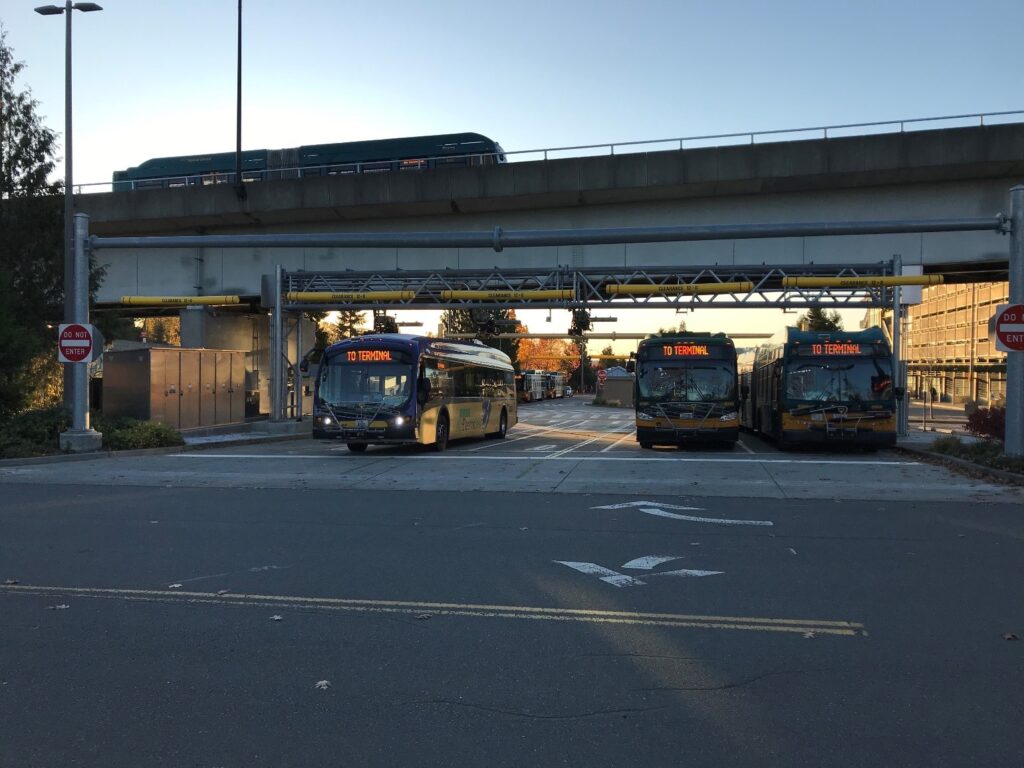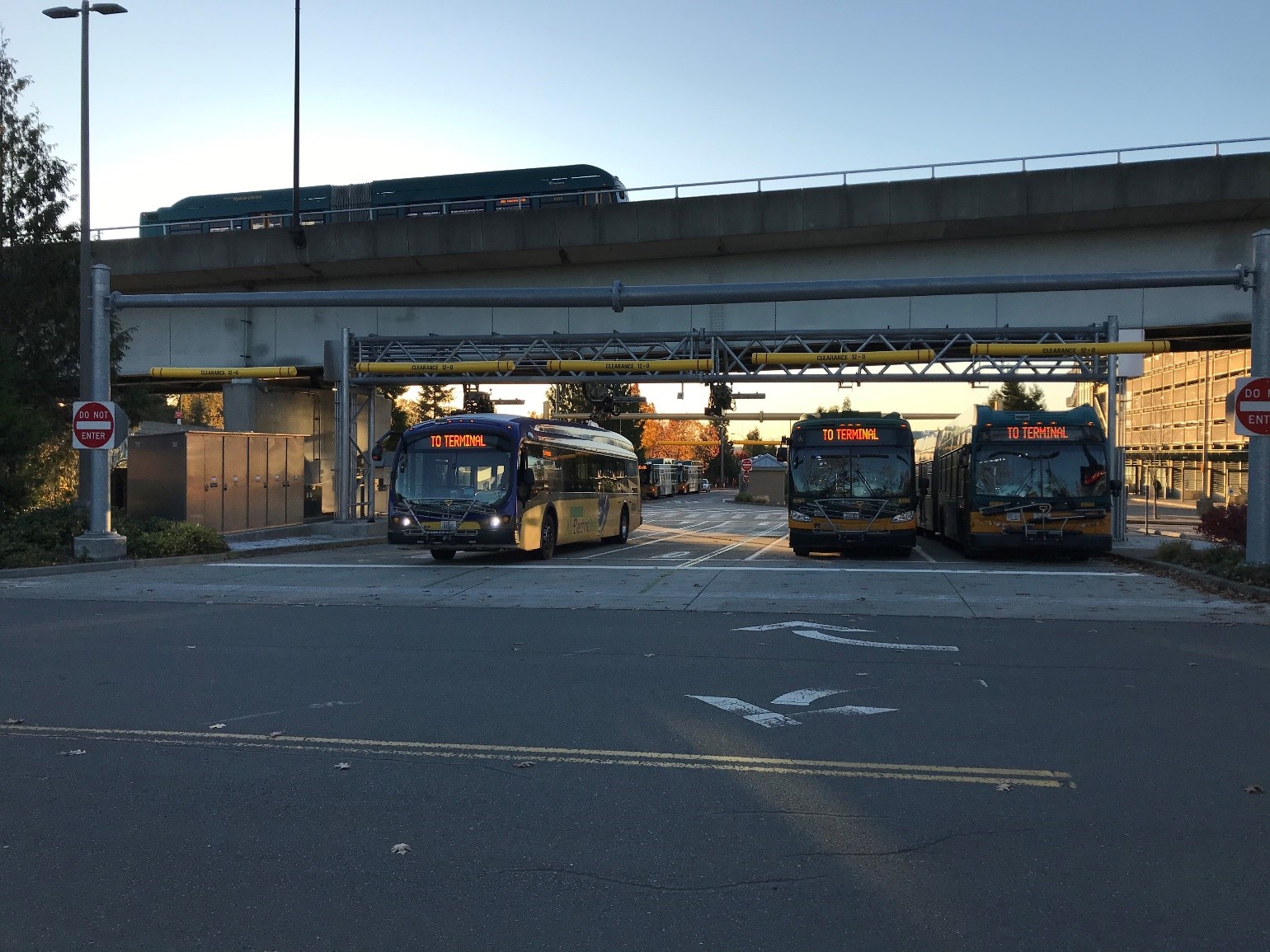
Eastgate P&R Rapid Charger Station
By Steve Olling, PE, PMP, ENV SP
The concept of a zero-emission bus fleet isn’t as far off as you might think. In fact, transit agency King County Metro has been using zero-emission trolley coaches in Seattle for nearly 80 years. The agency has also been recognized as a national leader in early adoption of diesel-electric hybrid buses.
King County Metro is well on their way to meeting their goal to have a zero-emission fleet by 2040. The agency has begun using battery electric coaches, along with continuing to use and modernize their electric trolley fleet. This meets around 11% of their goal already. Starting in 2020, Metro plans to only purchase zero-emission buses as older buses retire and to increase fleet size to meet growing service needs.
The agency will transition to a fleet of all-electric trolley and battery-electric buses that have no tailpipe, reducing bus noise and eliminating greenhouse gas and air pollutant emissions. Power will be purchased from sources that have no associated emissions from generation.
To support a zero-emission bus fleet, King County Metro is making operational changes and installing charging infrastructure. There are likely to be service adjustments to make the switch to a zero-emission fleet.
Parametrix is working with Metro to implement a world-class battery-electric bus program as part of their zero-emission fleet. The Parametrix team, which includes six subconsultants, is providing planning, engineering, cross discipline/department coordination, power service and electrical engineering, sustainability assessments, cost estimating and scheduling, and project controls services.
Metro used a $4.7 million Federal Transit Administration grant to acquire a small initial fleet of battery-electric buses. After successful testing, the agency purchased 11 short-range, rapid-charge Proterra electric buses. The 38-seat buses can travel up to 23 miles between charges and remain on the road up to 24 hours a day. Batteries take 10 minutes or less to charge. Maintenance costs for the new buses are lower than those of the diesel buses since electric buses have no engine, fuel system, exhaust system, or emissions treatment system.
This fleet is now being used on local bus routes, generating revenue. To support these electric buses, Parametrix has worked with Metro to manage the installation of four rapid charging stations – three at Eastgate and one at the Bellevue Base.
Metro is also testing ten longer range buses from three different manufactures (Proterra, New Flyer and BYD). These are a combination of 40 foot and 60 foot articulated buses. This testing has been underway since mid-2018 and will support the next fleets of bus procurement.
Steve is a senior transportation consultant based out of Parametrix’s Seattle, WA office. He has over 30 years of experience in the transportation industry, working in both the private and public sector. His experience includes a variety of projects – from intersection improvements to multi-modal corridor improvements. Before joining Parametrix, Steve worked for the Washington State Department of Transportation and the Port of Seattle.
What’s Next?
Metro South Base: The first large deployment of zero emission battery electric buses will happen at Metro’s South Base facility. An interim battery-electric bus facility will be needed to house 120 battery electric coaches. Parametrix recently completed a conceptual design study for this interim facility, set to open in 2022.
South Base Annex: The next large deployment will be a new base called South Base Annex, located adjacent to the current South Base. This will support 225 coaches. The design for this facility will begin in early 2020. The planned opening of this facility is fall 2025.
South Base Upgrades: After these two facilities are up and running, the next facility to upgrade is the existing main South Base to support 100% zero-emission battery-electric buses, therefore ending the diesel-hybrid era that is supported by this facility.
Remaining Bases: The remaining diesel bases will be beginning their transitional designs after south base design is underway, all with a goal of being zero emission by 2040.
About the Author

Steve Olling, PE, PMP, ENV SP
Steve is a senior transportation consultant based out of Parametrix’s Seattle, WA office. He has over 30 years of experience in the transportation industry, working in both the private and public sector. His experience includes a variety of projects – from intersection improvements to multi-modal corridor improvements. Before joining Parametrix, Steve worked for the Washington State Department of Transportation and the Port of Seattle.


